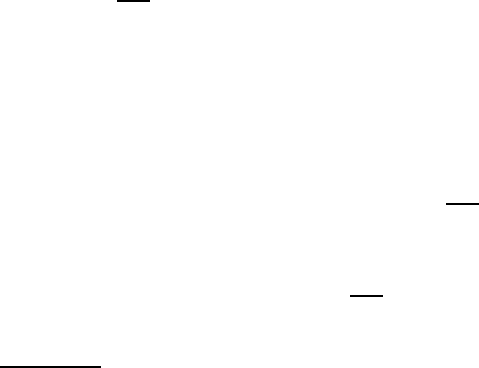Galdi G.P. An Introduction to the Mathematical Theory of the Navier-Stokes Equations: Steady-State Problems
Подождите немного. Документ загружается.


556 VIII Steady Generalized Oseen Flow in Exterior Domains
u = ϕv + ϑ Φ ∇E + w , q = ϕ p ,
where E i s the Laplace f unda mental solution defined in (II.9.1),
Φ =
Z
∂Ω
v
∗
· n ,
with n the unit outer norma l to ∂Ω, and w satisfies
∇ · w = −∇ϕ · (v + Φ∇E) in Ω
2R
,
w ∈ W
3,2
0
(Ω
2R
) ,
kwk
3,2
≤ C (kvk
2,2,Ω
2R
+ |Φ|) ,
(VIII.6.5)
where C = C(R, Ω). Clearly, ∇ϕ · (v + Φ∇E) ∈ W
2,2
0
(Ω
2R
). Moreover, since
2
Z
∂Ω
n · ∇E = −1 ,
it follows that
Z
Ω
2R
∇ϕ · (v + Φ∇E) =
Z
∂B
2R
(v + Φ∇E) · n −
Z
Ω
2R
ϕ∇· (v + Φ∇E)
=
Z
∂Ω
(v + Φ∇E) · n = 0 .
Thus, Theorem III.3.3 guarantees the existence of the field w. Furthermore,
the pair (u, q) obeys the f ollowing problem:
∆u + R
∂u
∂x
1
+ T (e
1
× x · ∇u − e
1
× v) = ∇ q + ∇ · G + g
∇ · u = 0
in R
3
,
lim
|x|→∞
u(x) = 0 ,
(VIII.6.6)
where
g = (∆ϕ)(v + Φ∇ E) + 2∇ϕ · ∇(v + Φ∇E) + R
∂ϕ
∂x
1
v
+T (e
1
×x · ∇ϕ)(v + Φ∇E)
−p∇ϕ −R(∇ϕ) · F + ∆w + R
∂w
∂x
1
+ T (e
1
×x · ∇w − e
1
× w),
G = RϕF −RΦ ϑ (e
1
⊗∇E) ,
2
Recall that n is t he unit outer normal to ∂Ω.

VIII.6 On the Pointwise Asymptotic Behavior of Generalized Solutions 557
and we have used the fact that e
1
×x · ∇(∇E) −e
1
×(∇E) = 0. Taking into
account that supp (θ) ⊂ B
3R
, we find that the function G satisfies
k∇ · Gk
2
≤ c
1
(R) R (k∇ · Fk
2
+ []F[]
2,R
+ |Φ|) ,
[|G|]
2,R
≤ c
1
(R)R([]F[]
2,R
+ |Φ|) .
(VIII.6.7)
We also observe that using several times the embedding Theorem II.3.3 and
the properties of w given in (VI II.6.5), we deduce
kgk
6
≤ c
2
([]F[]
2,R
+ kvk
2,2,Ω
2R
+ kqk
1,2,Ω
2R
+ kv
∗
k
3/2,2,∂Ω
) , (VIII.6.8)
with c
2
= c
2
(R, B), whenever R, T ∈ [0, B]. Thus, in view of (VIII.6.7),
(VIII.6.8), we check that the hypotheses of Theorem VIII.5.1 are satisfied, and
consequently, there exists a t least one solution (u, q) to (VIII.6.6) satisfying all
the properties listed in tha t theorem. Again by Theorem VIII.5.1, this solution
is unique in the class of generalized solutions, and so we must have u = u
and q = q + q
0
, where q
0
∈ R. However, q ∈ L
6
(R
3
) and q ∈ L
r
(R
3
), for all
r > 3/2, which impl ies q
0
= 0. Thus, recalling that u = v and q = p in Ω
2R
,
from Lemma VIII.6.1, (VIII.6.7), (VIII.6.8), (VIII.5.3), and the inequality
kpk
q,Ω
2R
≤ c
1
(R, q)kpk
6,Ω
≤ c
2
(R, q)|p|
1,2
, q ∈ [1, 6] , (VIII.6.9)
we find, on the one hand, that v, p satisfy (VIII.6.3), and on the other hand,
that they satisfy the estimate
kD
2
vk
2,Ω
2R + k∇vk
2,Ω
2R + []v[]
1,R,Ω
2R + kpk
r,Ω
2R + k∇pk
2,Ω
2R
≤ C([]F[]
2,R
+ k∇· F k
2
+ kv
∗
k
3/2,2,∂Ω
+ kvk
2,2,Ω
2R
+ kpk
1,2,Ω
2R
) .
This latter, in turn, combined with Lemma VIII.6.1 and with (VIII.6.9), yields
|v|
2,2
+ |v|
1,2
+ []v[]
1,R
+ |p|
1,2
+ kpk
q
1
+ kpk
q
2
,Ω
2R
≤ C ([]F[]
2,R
+ k∇ · F k
2
+ kv
∗
k
3/2,2,∂Ω
+ kvk
2,Ω
3R
+ kpk
2,Ω
3R
) ,
(VIII.6.10)
where C = C(Ω, R, q
1
, q
2
, B). By means of a standard argument that we have
already used several times, we will now show that
kvk
2,Ω
3R
+ kpk
2,Ω
3R
≤ C(k∇·Fk
2
+ []F[]
2,R
+ kv
∗
k
3/2,2,∂Ω
) , (VIII.6.11)
for some constant C satisfying the property stated in the theorem. Then,
combining (VIII.6.11) with (VIII.6.10 ), we will obtain (VIII.6.4), and this
will conclude the proof of the theorem. Assume that (VIII.6.11) does not
hold. Then, in view of the linearity of problem (VIII.0.2), (VIII.0.7), we can
find a sequence {F
n
, v
∗n
, R
n
, T
n
}, with R
n
, T
n
∈ [0, B], and a sequence of
corresponding solutions {v
n
, p
n
} such that
[|F
n
|]
2,R
n
+ k∇· F
n
k
2
+ kv
∗n
k
2−1/q,q,∂Ω
≤
1
n
,
kv
n
k
q,Ω
3R
+ kp
n
k
q,Ω
3R
= 1.
(VIII.6.12)

558 VIII Steady Generalized Oseen Flow in Exterior Domains
From (VIII.6.4), it follows that the sequence of solutions is bounded in the
norm defined by the left-hand side of (VIII.6.4) and that therefore, it con-
verges, in a suitable topolog y, to a pair {v
0
, p
0
} that belongs to the class
defined by (VIII.6.3). Since, in particular,
kv
n
k
1,2,Ω
3R
+ kp
n
k
1,2,Ω
3R
≤ M
with M independent of n, by Rel lich’s compactness theorem, Theorem II.5.2,
and by the second equation in (VIII.6.12) we infer
kv
0
k
q,Ω
3R
+ kp
0
k
q,Ω
3R
= 1. (VIII.6.13)
Moreover, using (VIII.6.12)
1
, it is easy to show that v
0
, p
0
is a solution of the
following boundary-value problem:
∆v
0
+ R
0
∂v
0
∂x
1
+ T
0
(e
1
× x · ∇v
0
− e
1
×v
0
) = ∇p
0
∇ · v
0
= 0
in Ω
v
0
= 0 a t ∂Ω,
(VIII.6.14)
where R
0
= lim
n→∞
R
n
, T
0
= lim
n→∞
T
n
. However, v
0
, p
0
satisfy (VIII.6.3),
so that in particular, v
0
is a weak solution to (VII I.6.14). Thus, by the unique-
ness Theorem VIII.2.1 we obta in v
0
= p
0
= 0,
3
contradicting (VIII.6.13). This
proves (VIII.6.11), and concludes the proof of the theorem.
ut
Remark VI II.6.1 The methods used in the proof of the previous theorem
provide pointwise asymptotic estimates for the velocity field. However, these
methods can be further exploited to give similar results al so for the derivatives
of the velocity and of the associa ted pressure fields. In particular, one can
prove the following two theorems, for whose proof we refer to Gal di (2003,
Theorem 4.1) and Galdi & Silvestre (2007b, T heorem 3 ), respectively.
Theorem VIII.6.2 Let Ω, F and v
∗
be as in Theorem VIII.6.1, and let v
be the corresponding generalized solution to (VIII.0.2), (VIII.0.7) with R = 0.
Suppose also that
[|D
i
F
ij
e
j
|]
3
+ [|D
j
D
i
F
ij
|]
4
< ∞
and v
∗
∈ W
2−1/q,q
(∂Ω) for a ll q > 1. Then, in addition to the properties
stated i n Theorem VIII.6.1, v a nd the associated pressure p satisfy
v ∈ W
2,q
loc
(Ω) , all q ≥ 1, [|∇v|]
2
< ∞,
p ∈ W
1,q
loc
(Ω), all q ≥ 1, [|p|]
2
+ [|∇p|]
3,Ω
R
< ∞, all R > δ(B).
Moreover, the following estimate holds:
3
Recall that, for instance, p
0
∈ L
6
(Ω).

VIII.6 On the Pointwise Asymptotic Behavior of Generalized Solutions 559
kvk
2,q,Ω
R
+ [|∇v|]
2
+ [|p|]
2
+ [|∇p|]
3,Ω
R
≤ c
[|F|]
2
+ [|D
i
F
ij
e
j
|]
3
+ [|D
j
D
i
F
ij
|]
4
+ kv
∗
k
2−1/q,q,∂Ω
,
where the constant c depends only on Ω, q, R, and B, whenever T ∈ [0, B].
Theorem VIII.6.3 Let Ω and v
∗
be as in Theorem VIII.6.1, f ∈ L
∞
(Ω)
with []f[]
5
2
,R
< ∞, and let v be the generalized solution to (VIII.0.2),
(VIII.0.7) corresponding to f and v
∗
.
4
Then, v and the associated pressure
field p satisfy
v ∈ W
2,2
loc
(D) ∩ D
1,2
(D) ∩D
2,2
(D), []v[]
1,R
+ []∇v[]
3
2
,R
< ∞
p ∈ W
1,2
(D),
along with the estimate
|v|
2,2
+ |v|
1,2
+ []v[]
1,1
+ []∇v[]
3
2
,R
+ kpk
1,2
≤ C
kv
∗
k
3
2
,2
+ R
−
1
2
[]f[]
5
2
,R
,
with C = C(Ω, B), whenever R, T ∈ (0, B).
Notice that in both theorems, the gradient of the velocity field decays exactly
as the g radient of the Stokes fundamental tensor (Theorem VIII.6.2) and that
of the Oseen fundamental tensor (Theorem VIII. 6.3).
Remark VI II.6.2 An interesting problem that can be naturally posed, is
to determine the asymptotic structure of a generalized solution. To date, the
investigation of this issue is still in progress. However, at least in the case
R = 0, Farwig & Hishida (2009) furnish a detailed picture, w hen the tensor
field F in Theorem VIII.6.1 has components in C
∞
0
(Ω), and the boundary
condition reduces to a rigid rotation, that is, v
∗
= e
1
×x. In particular, these
authors prove an asymptotic expansion, for large |x|, of the velocity field, and
they show that the leading term of this expansion is given by
e
1
·
Z
∂Ω
[T (v, p) + F] · n
u
1
(x) ,
where u
1
(x) = (U
11
(x), U
21
(x), U
31
(x)), and (U (x), q(x)) i s the Stokes fun-
damental solution. A crucial tool in the proof of this result is provided by the
fact that the field u
1
(x), q
1
(x) is a solution to the generalized Oseen system
with R = 0:
∆u
1
(x) + T (e
1
×x · ∇u
1
(x) − e
1
×u
1
(x)) = ∇q
1
(x) ,
∇ · u
1
(x) = 0 ,
for a ll x ∈ R
3
− {0},
4
Observe that the assumption on f implies that f ∈ D
−1,2
0
(Ω), as the reader will
easily prove. Furthermore, the statement of this result given in Galdi & Silvestre
(2007b) requires the condition
R
∂Ω
v
∗
· n = 0, w hich in fact, is not needed.

560 VIII Steady Generalized Oseen Flow in Exterior Domains
since, as the reader may wish to show,
e
1
×x ·∇u
1
(x) − e
1
×u
1
(x) = 0 , for all x ∈ R
3
−{0}.
VIII.7 Existence, Uniqueness, and L
q
-Esti mates. The
case R = 0
In this and the next section we will investigate existence, uniqueness, and
associated estimates of solutions corresponding to right-hand si de f from
Lebesgue space L
q
, and boundary data v
∗
in the trace space W
2−2/q,q
(∂Ω),
for suitable values of q. Since the results for the cases R = 0 and R 6= 0 are
quite different, we prefer to analyze them separately, beginning with the case
R = 0 in the current section, while deferring the other case to the following
one.
The starting point of our analysis (regardless of whether R = 0 or 6= 0) is
an appropriate uniqueness result. Precisely, we have the following.
Lemma VIII.7.1 Suppose that for some r ∈ (1, ∞) and all R > 0, (u, q) ∈
W
2,r
(B
R
) × W
1,r
(B
R
) is a solution to (VIII.5.1)
1,2
corresponding to f = 0.
The following prop erties hold:
(a) If
u =
N
X
i=1
u
i
, u
i
∈ L
q
i
(R
3
) , for some q
i
∈ (1, ∞) , i = 1, . . . , N ,
(VIII.7.1)
then u(x) = 0 , ∇q(x) = 0 for a.a . x ∈ R
3
.
(b) If
D
2
u =
M
X
i=1
b
u
i
,
b
u
i
∈ L
bq
i
(R
3
) , for some bq
i
∈ (1, ∞) , i = 1, . . ., M ,
(VIII.7.2)
then D
2
u(x) = 0 for a.a. x ∈ R
3
.
Proof. We begin by proving the property in (a). For simplicity, we shall
consider the case N = 2, leaving to the reader the simple task of estab-
lishing the result in the general case. If we perform the change of variables
(VIII.5.9)– (VIII. 5.11), the problem (VIII.5.1) (with f = 0) produces the fol-
lowing Cauchy problem:
∂w
∂t
= ∆w + R
∂w
∂χ
1
−∇π
∇ · w = 0
in R
3
× (0, ∞) ,
lim
t→0+
kw(t) − uk
q,B
R
= 0 ,
(VIII.7.3)

VIII.7 Existence, Uniqueness, and L
q
-Estimates. T he case R = 0 561
where q = min{q
1
, q
2
}, and R is an arbitrary posi tive number. Now let W
i
=
W
i
(χ, t), i = 1, 2, be the solution that we constructed in Theorem VIII.4.3
to the following Cauchy problem:
∂W
i
∂t
= ∆W
i
+ R
∂W
i
∂χ
1
∇ · W
i
= 0
in R
3
×(0, ∞) ,
lim
t→0
kW
i
(t) − u
i
k
q
i
= 0 .
(VIII.7.4)
As we know from that theorem, W
i
satisfies, in particular, the following
properties for i = 1, 2:
W
i
∈ L
q
i
(R
3
T
) , all T > 0 ,
∂W
i
∂t
, D
2
W
i
∈ L
q
i
loc
((0, T ] × R
3
)
kW
i
(t)k
r
≤ c
i
t
−3(1/q−1/r)/2
ku
i
k
q
i
, i = 1, 2 , all t > 0 ,
(VIII.7.5)
where r > q ≡ max{q
1
, q
2
}. Therefore, from (VIII.7.3) and (VIII.7.4) we infer
that the vector field W ≡ w − W
1
− W
2
satisfies
∂W
∂t
= ∆W + R
∂W
∂χ
1
+ ∇π
∇· W = 0
in R
3
× (0, ∞) ,
lim
t→0
kW (t)k
q,B
R
= 0 ,
(VIII.7.6)
where R is an arbitrary positive number. Taki ng also into account that (see
(VIII.5.15))
∂w
∂t
= −T Q(t) · (e
1
×x ·∇u − e
1
× u)
by the assumptions made on u a nd q, we easily deduce
∂w
∂t
, D
2
w , ∇π ∈ L
r
loc
(R
3
T
) , for all T > 0.
Moreover, obviously,
w = w
1
+ w
2
, w
i
∈ L
q
i
(R
3
T
) , i = 1, 2 , for all T > 0.
Consequently, from these latter prop erties and from (VIII.7.5)
1,2
we find that
the fields W , π satisfy the assumptions of Lemma VIII.4.2, so that we conclude
w = W
1
+ W
2
, ∇π = 0 a.e. in R
3
T
. (VIII.7.7)
Recalling that π(χ, t) = q(Q
>
(t) · χ, t), x = Q
>
· χ, the second relation in
(VIII.8.11) delivers ∇q = 0 in R
3
. Furthermore, taking into account that
w(χ, t) = Q(t) · u(Q
>
(t) ·χ), from (VIII.7.7) and (VIII.7.5)
3
we also have

562 VIII Steady Generalized Oseen Flow in Exterior Domains
kuk
r
= kw(t)k
r
≤ kW
1
(t)k
r
+ kW
2
(t)k
r
≤ c t
−3(1/q−1/r )/2
(ku
1
k
q
1
+ ku
2
k
q
2
) .
Letting t → ∞ in this relation gives kuk
r
= 0, which concludes the proof o f
part (a). We shall next prove part (b), aga in for the simplest case M = 2. We
recall that by Theorem VIII.1.1, u, q ∈ C
∞
(R
3
), which implies tha t (w, π)
is of class C
∞
in space and time. Thus, setting w := ∆w, q := ∆q, from
(VIII.7.3) and (VIII.5.16) we deduce
∂w
∂t
= ∆w + R
∂w
∂χ
1
−∇q
∇ · w = 0
in R
3
× (0, ∞) ,
lim
t→0 +
kw − ∆uk
bq,B
R
= 0 ,
(VIII.7.8)
where bq = min{bq
1
, bq
2
}, and R > 0 is arbitrary. We next repeat for the problem
(VIII.7.8) exactly the same argument used for the proof of the property in
(a), and show that ∆u = 0 a.e. in R
3
T
. In view of the assumption on D
2
u and
Exercise II.11.11, we thus conclude that D
2
u = 0 a.e. in R
3
T
, and the proof of
the lemma is complete.
ut
An important consequence of the previous result is the following general
uniqueness result.
Theorem VIII.7.1 Let Ω be locally Lipschitz, and let (v
i
, p
i
), i = 1, 2, be
two solutions to (VIII.0.7 ), (VIII.0.2) corresponding to the same data f and
v
∗
and such that for all R > δ(Ω
c
),
(v
i
, p
i
) ∈ W
2,q
i
(Ω
R
) ×W
1,q
i
(Ω
R
) , v
i
∈ L
r
i
(Ω) ,
for som e q
i
, r
i
∈ (1, ∞), i = 1, 2 .
(VIII.7.9)
Then v
1
= v
2
, ∇(p
1
− p
2
) = 0, a.e. in Ω.
Proof. Set v = v
1
− v
2
, p = p
1
−p
2
. From (VIII.0 .7) we obtain
∆v + R
∂v
∂x
1
+ T (e
1
× x · ∇v − e
1
× v) = ∇p
∇ · v = 0
in Ω
v = 0 at ∂Ω .
(VIII.7.10)
In view of the assumptio ns and Theorem VIII.1.1, it follows, in particular,
that
(v, p) ∈ [C
∞
(Ω) × C
∞
(Ω)] ∩ [W
2,2
(Ω
ρ
) ×W
1,2
(Ω
ρ
)] , for all ρ > δ(Ω
c
).
(VIII.7.11)

VIII.7 Existence, Uniqueness, and L
q
-Estimates. T he case R = 0 563
For a fixed σ > δ(Ω
c
), let ψ = ψ(x) be a smooth “cut-off” function that is
0 for | x| ≤ σ and 1 for |x| ≥ 2σ, and set u = ψ v + w, Φ = ψ p, where w
satisfies the foll owing properties:
∇ · w = −v · ∇ψ in Ω
σ,2σ
, w ∈ C
∞
0
(Ω
σ,2σ
) ,
kwk
2,q,R
3
≤ c kvk
1,q ,Ω
σ,2σ
.
(VIII.7.12)
Since
Z
Ω
σ,2σ
v ·∇ψ =
Z
Ω
2σ
∇·(ψv) =
Z
∂B
2σ
ψv ·n = −
Z
∂Ω
v ·n = 0 , (VIII.7.13)
from Theorem III.3.3 we know that problem (VIII.7.12) has at least one solu-
tion. By a direct computation that starts with (VIII.7.10), we thus find that
the pair (u, Φ) i s a solution to the following problem:
∆u + R
∂u
∂x
1
+ T (e
1
× x · ∇u − e
1
× u) = ∇Φ + F
∇ · u = 0
in R
3
, (VII I .7.14)
with
F = ∆w + R
∂w
∂x
1
+ T
e
1
× w − e
1
×w
+Rv
∂ψ
∂x
1
−p ∇ψ + 2∇ψ · ∇v + v ∆ψ .
(VIII.7.15)
In view of (VIII.7.11) and (VIII.7.12), we deduce F ∈ C
∞
0
(Ω), and so, in
particular, F ∈ D
1,2
0
(R
3
). By Theorem VIII.1.1 and Theorem VIII.1.2 , we
then infer that problem (VIII.7.14) has at least o ne solution,
(u, Φ) ∈ [ D
1,2
0
(R
3
) ∩ L
6
(R
3
) ∩ C
∞
(R
3
)] × C
∞
(R
3
) . (VIII.7.16)
Since
u −u = u + (w − ψv
1
) + ψv
2
≡ u
1
+ u
2
+ u
3
is a solution to (VIII.7.14) with F ≡ 0, and since from (VII I.7.16), (VIII. 7.12)
and the assumption (VIII.7.9), we have u
i
∈ L
s
i
(R
3
), for suitable s
i
∈ (1, ∞),
i = 1, 2, 3, by Lemma VIII.7.1 we infer u = u. This latter, in turn, by the
properties of ψ and by (VIII.7.11) a nd (VIII.7.16), implies, in particular,
v ∈ D
1,2
(Ω
2σ
) .
This information along with (VIII. 7.11) furnishes that v is a generalized so-
lution to (VIII.7.10), and so by Lemma VIII.2.3, we conclude that v = 0 in
Ω, which ends the proof of the lemma. ut
We shall now begi n our investigation of the summ abil ity properties of
solutions to (VI II.0.7), (VIII.0.2), by considering first the case R = 0 and
Ω = R
3
. The following lemma holds.
564 VIII Steady Generalized Oseen Flow in Exterior Domains
Lemma VIII.7.2 Let f ∈ L
q
(R
3
), for some q ∈ (1, ∞). Then, the problem
∆v + T (e
1
×x · ∇v − e
1
× v) = ∇p + f
∇· v = 0
)
a.e. in R
3
(VIII.7.17)
has at least one solution v, p such that
(v, p) ∈ D
2,q
(R
3
) ∩ D
1,q
(R
3
) ,
(e
1
×x · ∇v − e
1
×v) ∈ L
q
(R
3
) ,
(VIII.7.18)
satisfying
|v|
2,q
+ |p|
1,q
+ T ke
1
× x · ∇v − e
1
× vk
q
≤ c
1
kfk
q
, (VIII.7.19)
where c
1
= c
1
(q) > 0. If 1 < q < 3, there is a solution that in addition to
(VIII.7.19) also satisfies
(v, p) ∈ D
1,3q/(3−q)
(R
3
) ∩L
3q/(3−q)
(R
3
) (VIII.7.20)
along with the inequality
|v|
1,3q/(3−q)
+ kpk
3q/(3−q)
≤ c
2
kfk
q
(VIII.7.21)
and c
2
= c
2
(q) > 0. Furthermore, if 1 < q < 3/2, we can find a solutio n that
in addition to (VIII.7.19) and (VIII.7.19), satisfies further,
v ∈ L
3q/(3−2q)
(R
3
) (VII I.7.22)
and
kvk
3q/(3−2q)
≤ c
3
kf k
q
, (VIII.7.23)
with c
3
= c
3
(q) > 0.
Finally, if f ∈ L
q
(R
3
) for all q ∈ (1, ∞), there exists a solution (v, p) to
(VIII.7.17) satisfying (VIII.7.18 )–(VI II.7.23) for all specified values of q.
Proof. It will be enough to prove the existence of a solution satisfying the
stated estimates for the appropriate derivatives of v and p only, in that the
inequality for the “rotationa l” term (e
1
×x·∇v−e
1
×v) becomes a consequence
of (VIII.7.17)
1
and these estimates. Let us take first f ∈ C
∞
0
(R
3
). Then, from
Theorem VIII.5.1, we know that problem (VIII.7.17) has one and only one
smooth sol ution (v, p) such that
v ∈ L
s
1
(R
3
) ∩ D
1,s
2
(R
3
) ∩ D
2,s
3
(R
3
) , all s
1
> 3, s
2
> 3/2, and s
3
> 1.
(VIII.7.24)
Making the change of variables (VIII.5.9)–(VIII.5.11) (with u ≡ v), we showed
in Section VIII.5 that problem (VIII.7.17) goes into the f ollowing Cauchy
problem:

VIII.7 Existence, Uniqueness, and L
q
-Estimates. T he case R = 0 565
∂w
∂t
= ∆w − ∇π + F
∇ · w = 0
in R
3
×(0, ∞) ,
lim
t→0 +
kw(t) − vk
s
1
= 0 ,
(VIII.7.25)
where F (χ, t) = −Q(t) ·g( Q
>
(t)·χ). Then, from Theorem VIII.4.1, Theorem
VIII.4.3, Lemma VIII.4.2, and (VI II.7.24), we at once obtain that we may
write w = w
1
+ w
2
, where (w
1
, π) satisfy (VIII.7.25) with v ≡ 0, while
w
2
(x, t) =
1
4π t
3/2
Z
R
3
e
−|x−y|
2
/4t
v(y)dy . (VIII.7.26)
Again by Theorem VIII.4.1, we obtain
Z
T
0
|w
1
(t)|
q
2,q
+ |π(t)|
q
1,q
dt ≤ C
1
Z
T
0
kF ( t)k
q
q
dt , (VIII.7.27)
with a constant C
1
independent of T > 0. Furthermore, by differentiating
twice both sides of (VIII.7 .26) with respect to the x va riable, and then apply-
ing Young’s inequality (II.11.2), we deduce
|w
2
(t)|
2,q
≤ C
2
t
−
3
2
“
1
s
3
−
1
q
”
|v|
2,s
3
,
with C
2
independent of t > 0, and s
3
∈ (1, q). From this latter it follows that
Z
T
0
|w
2
(t)|
q
2,q
dt ≤ C
3
T
−
3
2
“
q
s
3
−1
”
+1
|v|
q
2,s
3
, (VIII.7.28)
with C
3
independent of T . Consequently, recalling that
|v|
2,q
= |w(t)|
2,q
, |p|
1,q
= |π(t)|
1,q
, kf k
q
= kF (t)k
q
, for all t ≥ 0 ,
we obtain
T
|v|
q
2,q
+ |p|
q
1,q
≤ C
4
Z
T
0
|w
1
(t)|
q
2,q
+ |w
2
(t)|
2,q
+ |π(t)|
q
1,q
dt
≤ C
5
Z
T
0
kF (t)k
q
q
dt + T
−
3
2
“
q
s
3
−1
”
+1
|v|
q
2,s
3
= C
5
T kfk
q
q
+ T
−
3
2
“
q
s
3
−1
”
+1
|v|
q
2,s
3
.
Dividing both sides of this inequality by T , and passing to the limit T → ∞,
we then get
|v|
2,q
+ |p|
1,q
≤ C
6
kfk
q
, (VIII.7.29)
